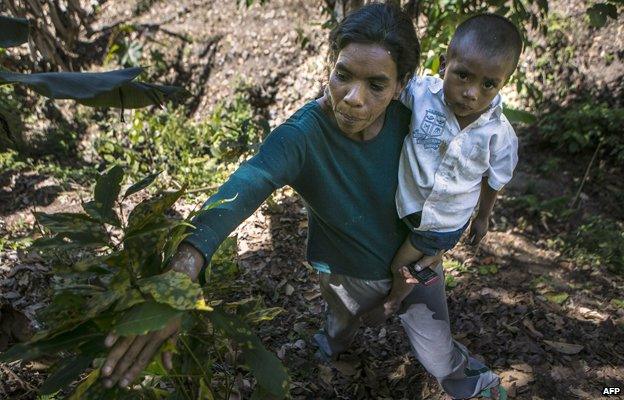Who, What, Why: What is coffee rust?
- Published

The US is stepping up support for coffee farmers in Central America. What is the coffee leaf rust that is killing their crop and threatens to push up the price of beans in the shops?
Coffee's plague starts with yellow spots and what look like burn marks. They form on the leaves of the coffee plant, causing the foliage to wither until the tree resembles a skeleton. It stops bean-producing cherries from growing. This is coffee rust or roya, caused by the hemileia vastatrix fungus. For two years it has been ravaging Central America and the Caribbean. Arabica plants - used for espresso and filter coffee - are particularly vulnerable. Arabica accounts for almost all production in the worst affected countries of Costa Rica, Dominican Republic, El Salvador, Guatemala, Honduras, Jamaica, Nicaragua, and Panama.
The current epidemic is the worst seen since the fungus appeared in Central America in 1976, says the International Coffee Organisation. More than half of the region's coffee-producing areas are affected. In 2013 alone, production fell 20%.
The US government worries that farmers could swap coffee for drug-producing crops, external. It has announced a $5m project for researchers at Texas A&M university to look at ways of eradicating the fungus. But that will take time. In the meantime, spraying with copper sulphate solution can help control an outbreak. The long-term answer is to replant with fungus-resistant varieties as Colombia has done, says Mauricio Galindo, head of operations at the ICO. And the US research will help with that, he says.
The dry season, which usually kills off the fungus, was extremely wet in 2011/2012, so coffee rust spread, says Will Corby of bean importer Mercanta. The other factor is altitude. Plants over 1,000 metres used to be safe but the fungus has mutated in the past two years and is now aggressive above this level.
The price of coffee from countries like Guatemala will rise. There will be less impact on instant coffee as it is mostly made from robusta rather than arabica. Even the price of a latte at a coffee shop should not rise noticeably - only about 8% of the cost is down to the beans. But Central American ground or bean coffee sold by shops and supermarkets will go up, says Galindo.
Follow @BBCNewsMagazine, external on Twitter and on Facebook, external